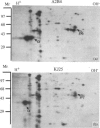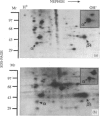Abstract
The region responsible for T-cell receptor (TCR)alpha and beta chain assembly has previously been shown to reside in their extracellular domains. In an attempt to delineate further the structural requirements for TCR alpha and beta chain assembly, chimeric TCR beta chains with increasing length of constant (C) region and mutant TCR beta chains with C-domain point mutations were constructed. Their ability to assemble with wild-type TCR alpha chain was evaluated in non-T (COS cells) or T cells. The results reveal that the C beta domain is the binding region to TCR alpha chain, whereas the intact variable (V), diversity (D) and joining (J) regions with a short C-domain of beta chain are not sufficient for the TCR alpha and beta chain assembly. The unique interchain disulphide bond between TCR alpha and beta chains is not required for the TCR alpha beta heterodimer formation.
Full text
PDF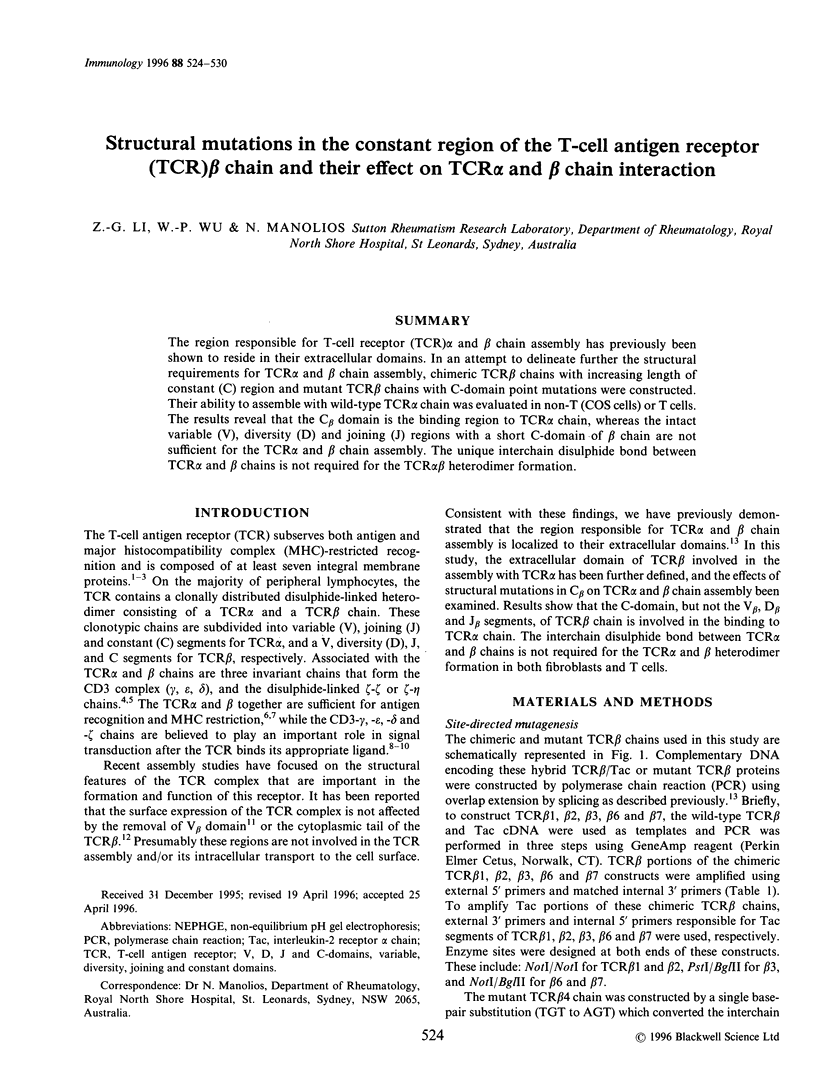

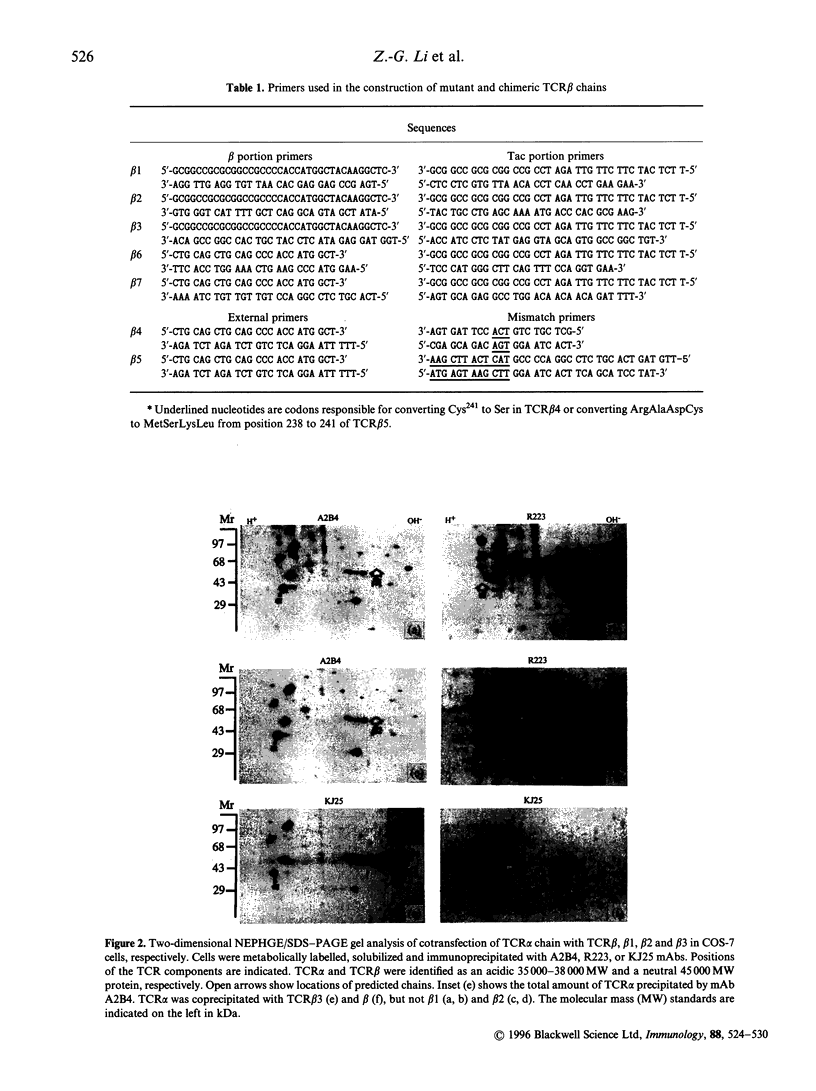
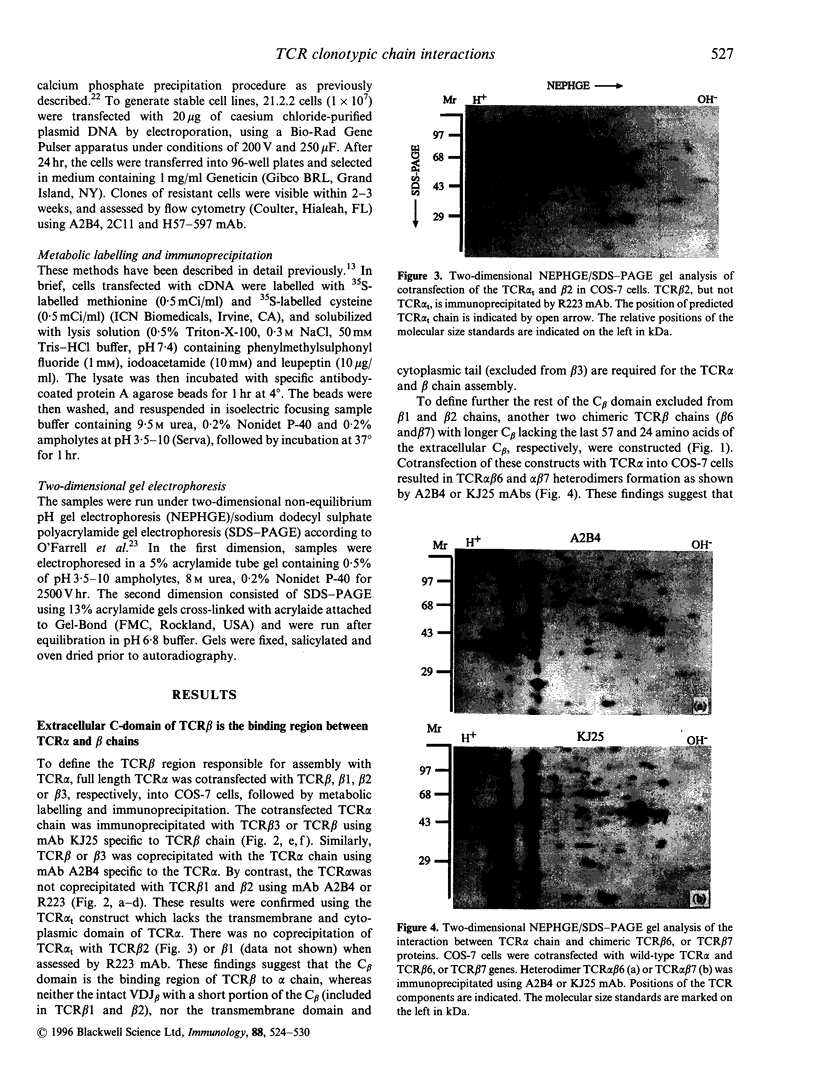
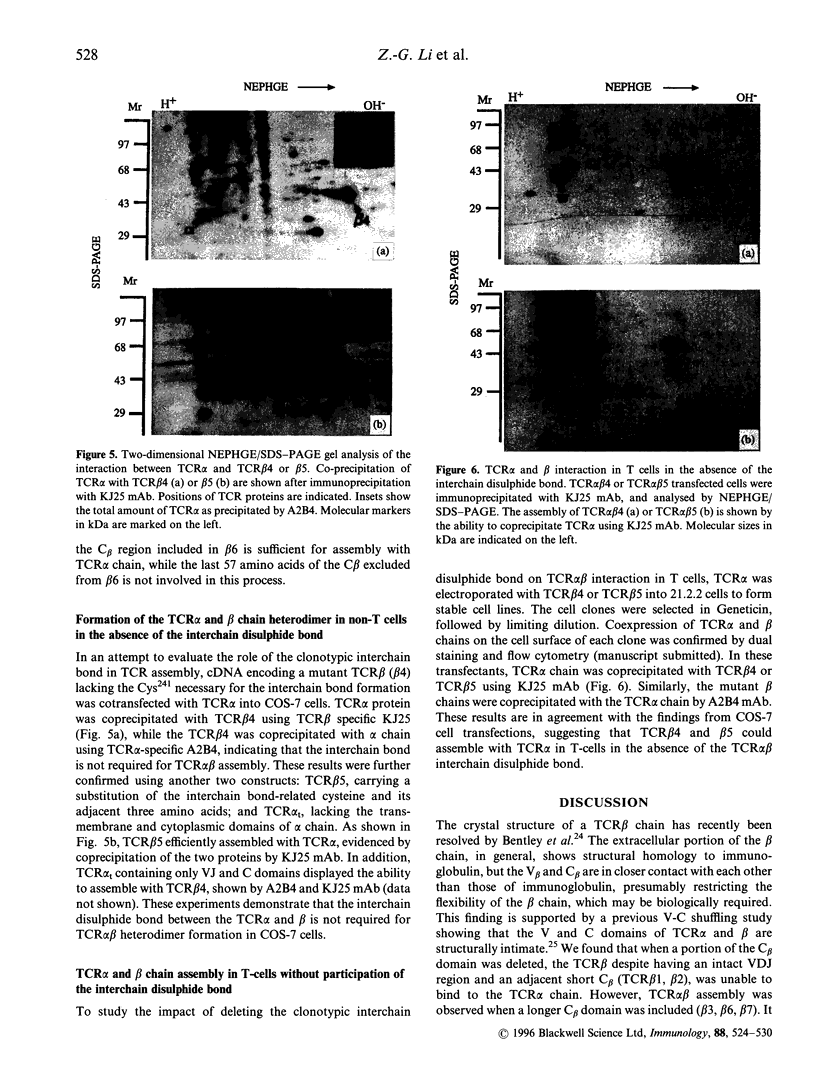
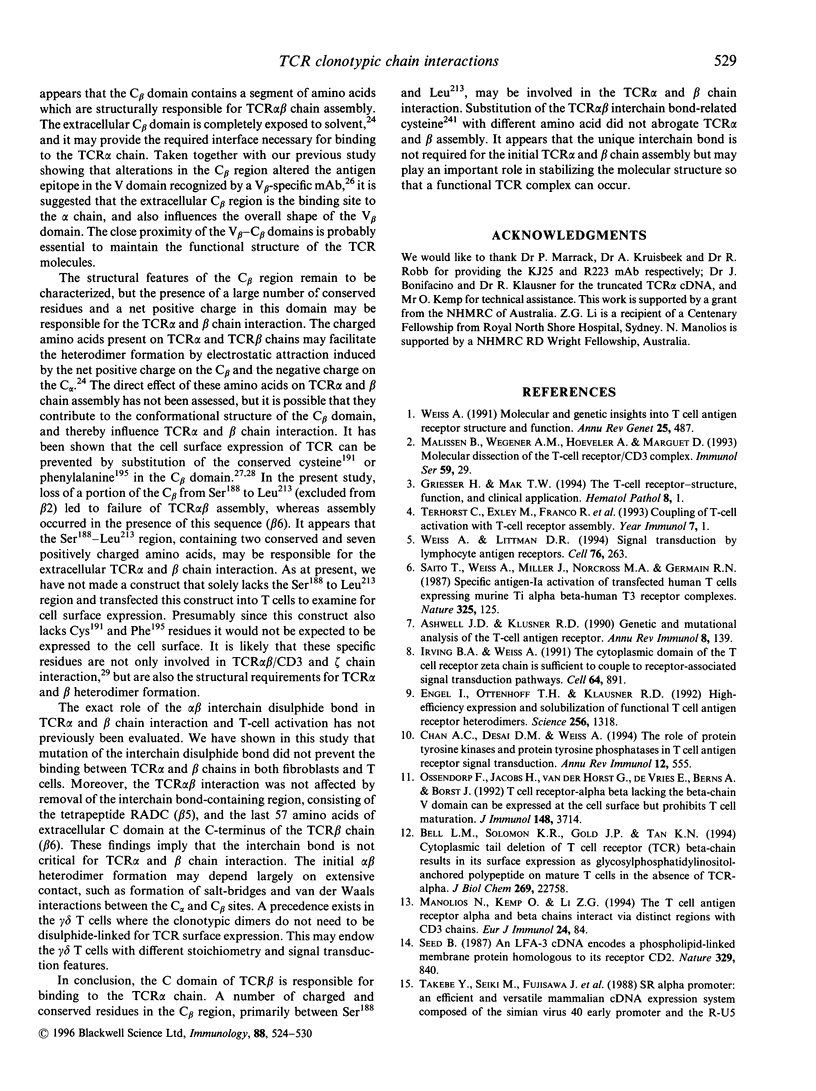
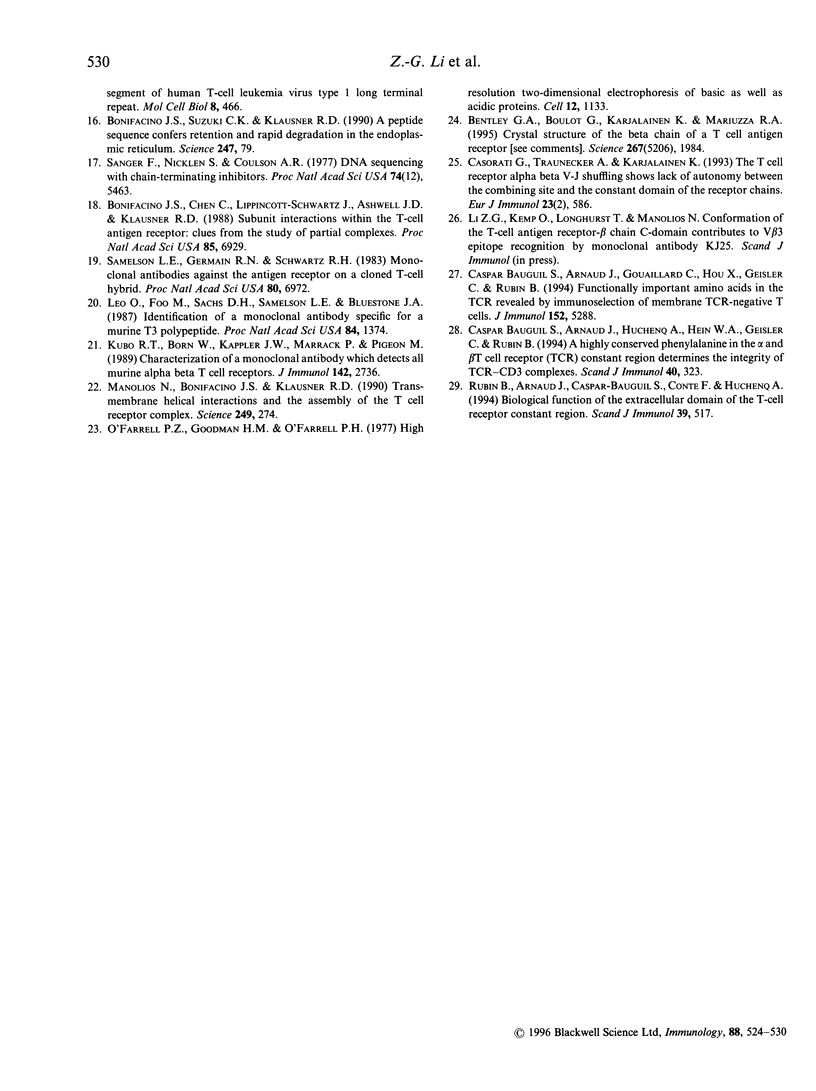
Images in this article
Selected References
These references are in PubMed. This may not be the complete list of references from this article.
- Ashwell J. D., Klusner R. D. Genetic and mutational analysis of the T-cell antigen receptor. Annu Rev Immunol. 1990;8:139–167. doi: 10.1146/annurev.iy.08.040190.001035. [DOI] [PubMed] [Google Scholar]
- Bell L. M., Solomon K. R., Gold J. P., Tan K. N. Cytoplasmic tail deletion of T cell receptor (TCR) beta-chain results in its surface expression as glycosylphosphatidylinositol-anchored polypeptide on mature T cells in the absence of TCR-alpha. J Biol Chem. 1994 Sep 9;269(36):22758–22763. [PubMed] [Google Scholar]
- Bentley G. A., Boulot G., Karjalainen K., Mariuzza R. A. Crystal structure of the beta chain of a T cell antigen receptor. Science. 1995 Mar 31;267(5206):1984–1987. doi: 10.1126/science.7701320. [DOI] [PubMed] [Google Scholar]
- Bonifacino J. S., Chen C., Lippincott-Schwartz J., Ashwell J. D., Klausner R. D. Subunit interactions within the T-cell antigen receptor: clues from the study of partial complexes. Proc Natl Acad Sci U S A. 1988 Sep;85(18):6929–6933. doi: 10.1073/pnas.85.18.6929. [DOI] [PMC free article] [PubMed] [Google Scholar]
- Bonifacino J. S., Suzuki C. K., Klausner R. D. A peptide sequence confers retention and rapid degradation in the endoplasmic reticulum. Science. 1990 Jan 5;247(4938):79–82. doi: 10.1126/science.2294595. [DOI] [PubMed] [Google Scholar]
- Casorati G., Traunecker A., Karjalainen K. The T cell receptor alpha beta V-J shuffling shows lack of autonomy between the combining site and the constant domain of the receptor chains. Eur J Immunol. 1993 Feb;23(2):586–589. doi: 10.1002/eji.1830230246. [DOI] [PubMed] [Google Scholar]
- Caspar-Bauguil S., Arnaud J., Gouaillard C., Hou X., Geisler C., Rubin B. Functionally important amino acids in the TCR revealed by immunoselection of membrane TCR-negative T cells. J Immunol. 1994 Jun 1;152(11):5288–5298. [PubMed] [Google Scholar]
- Caspar-Bauguil S., Arnaud J., Huchenq A., Hein W. R., Geisler C., Rubin B. A highly conserved phenylalanine in the alpha, beta-T cell receptor (TCR) constant region determines the integrity of TCR/CD3 complexes. Scand J Immunol. 1994 Sep;40(3):323–336. doi: 10.1111/j.1365-3083.1994.tb03469.x. [DOI] [PubMed] [Google Scholar]
- Chan A. C., Desai D. M., Weiss A. The role of protein tyrosine kinases and protein tyrosine phosphatases in T cell antigen receptor signal transduction. Annu Rev Immunol. 1994;12:555–592. doi: 10.1146/annurev.iy.12.040194.003011. [DOI] [PubMed] [Google Scholar]
- Engel I., Ottenhoff T. H., Klausner R. D. High-efficiency expression and solubilization of functional T cell antigen receptor heterodimers. Science. 1992 May 29;256(5061):1318–1321. doi: 10.1126/science.1598575. [DOI] [PubMed] [Google Scholar]
- Griesser H., Mak T. W. The T-cell receptor--structure, function, and clinical application. Hematol Pathol. 1994;8(1-2):1–23. [PubMed] [Google Scholar]
- Irving B. A., Weiss A. The cytoplasmic domain of the T cell receptor zeta chain is sufficient to couple to receptor-associated signal transduction pathways. Cell. 1991 Mar 8;64(5):891–901. doi: 10.1016/0092-8674(91)90314-o. [DOI] [PubMed] [Google Scholar]
- Kubo R. T., Born W., Kappler J. W., Marrack P., Pigeon M. Characterization of a monoclonal antibody which detects all murine alpha beta T cell receptors. J Immunol. 1989 Apr 15;142(8):2736–2742. [PubMed] [Google Scholar]
- Leo O., Foo M., Sachs D. H., Samelson L. E., Bluestone J. A. Identification of a monoclonal antibody specific for a murine T3 polypeptide. Proc Natl Acad Sci U S A. 1987 Mar;84(5):1374–1378. doi: 10.1073/pnas.84.5.1374. [DOI] [PMC free article] [PubMed] [Google Scholar]
- Malissen B., Wegener A. M., Hoeveler A., Marguet D. Molecular dissection of the T-cell receptor/CD3 complex. Immunol Ser. 1993;59:29–40. [PubMed] [Google Scholar]
- Manolios N., Bonifacino J. S., Klausner R. D. Transmembrane helical interactions and the assembly of the T cell receptor complex. Science. 1990 Jul 20;249(4966):274–277. doi: 10.1126/science.2142801. [DOI] [PubMed] [Google Scholar]
- Manolios N., Kemp O., Li Z. G. The T cell antigen receptor alpha and beta chains interact via distinct regions with CD3 chains. Eur J Immunol. 1994 Jan;24(1):84–92. doi: 10.1002/eji.1830240114. [DOI] [PubMed] [Google Scholar]
- O'Farrell P. Z., Goodman H. M., O'Farrell P. H. High resolution two-dimensional electrophoresis of basic as well as acidic proteins. Cell. 1977 Dec;12(4):1133–1141. doi: 10.1016/0092-8674(77)90176-3. [DOI] [PubMed] [Google Scholar]
- Ossendorp F., Jacobs H., van der Horst G., de Vries E., Berns A., Borst J. T cell receptor-alpha beta lacking the beta-chain V domain can be expressed at the cell surface but prohibits T cell maturation. J Immunol. 1992 Jun 15;148(12):3714–3722. [PubMed] [Google Scholar]
- Rubin B., Arnaud J., Caspar-Bauguil S., Conte F., Huchenq A. Biological function of the extracellular domain of the T-cell receptor constant region. Scand J Immunol. 1994 Jun;39(6):517–525. doi: 10.1111/j.1365-3083.1994.tb03408.x. [DOI] [PubMed] [Google Scholar]
- Saito T., Weiss A., Miller J., Norcross M. A., Germain R. N. Specific antigen-Ia activation of transfected human T cells expressing murine Ti alpha beta-human T3 receptor complexes. Nature. 1987 Jan 8;325(7000):125–130. doi: 10.1038/325125a0. [DOI] [PubMed] [Google Scholar]
- Samelson L. E., Germain R. N., Schwartz R. H. Monoclonal antibodies against the antigen receptor on a cloned T-cell hybrid. Proc Natl Acad Sci U S A. 1983 Nov;80(22):6972–6976. doi: 10.1073/pnas.80.22.6972. [DOI] [PMC free article] [PubMed] [Google Scholar]
- Sanger F., Nicklen S., Coulson A. R. DNA sequencing with chain-terminating inhibitors. Proc Natl Acad Sci U S A. 1977 Dec;74(12):5463–5467. doi: 10.1073/pnas.74.12.5463. [DOI] [PMC free article] [PubMed] [Google Scholar]
- Seed B. An LFA-3 cDNA encodes a phospholipid-linked membrane protein homologous to its receptor CD2. 1987 Oct 29-Nov 4Nature. 329(6142):840–842. doi: 10.1038/329840a0. [DOI] [PubMed] [Google Scholar]
- Terhorst C., Exley M., Franco R., Hall C., Kang J., Mueller B., Sancho J., She J., Wileman T. Coupling of T-cell activation with T-cell receptor assembly. Year Immunol. 1993;7:1–24. [PubMed] [Google Scholar]
- Weiss A., Littman D. R. Signal transduction by lymphocyte antigen receptors. Cell. 1994 Jan 28;76(2):263–274. doi: 10.1016/0092-8674(94)90334-4. [DOI] [PubMed] [Google Scholar]
- Weiss A. Molecular and genetic insights into T cell antigen receptor structure and function. Annu Rev Genet. 1991;25:487–510. doi: 10.1146/annurev.ge.25.120191.002415. [DOI] [PubMed] [Google Scholar]






